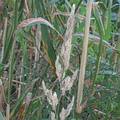科學家新報告 探究外來種利甘草強盛之謎
 最新的利甘草(reed canarygrass)研究報告發現,一種新的機制可以解釋為何有些植物會在移植到新的地區時變得具有侵略性。在其原生地歐洲,利甘草並不會排擠其他植物或擴張領域。但是在十九世紀中葉引進美國時,利甘草變得非常猖獗,扼殺了其他溼地本土植物的生存空間。這種草已經被10州視為侵略性物種,並且還在蔓延中。
最新的利甘草(reed canarygrass)研究報告發現,一種新的機制可以解釋為何有些植物會在移植到新的地區時變得具有侵略性。在其原生地歐洲,利甘草並不會排擠其他植物或擴張領域。但是在十九世紀中葉引進美國時,利甘草變得非常猖獗,扼殺了其他溼地本土植物的生存空間。這種草已經被10州視為侵略性物種,並且還在蔓延中。
2月27日出版的《國家科學院院刊》中一份研究報告指出,這種草的侵略性並非來自於單一種種類,而是來自於從歐洲各區域不同草種被引進的歷史。數十年來,美國農人和其他人種植利甘草作為家畜的飼料,或作為水土保持及廢水處理之用;他們將利甘草遠遠帶離法國、捷克和芬蘭等原生地。
研究人員認為,這些多元的引進方式和之後的混種,創造出一種生物性優勢。由於從歐洲大陸吸收了多元的基因,在美國出現的新品種具有更高的基因多樣性,並且比它們在大西洋對岸的兄弟品種更具有潛在的優勢。
「這並不是你從法國帶了一些草種到美國,然後它們就突然變得具有侵略性,」該研究的協同作者、佛蒙特大學植物生物學副教授莫洛夫斯基(Jane Molofsky)說道,「而是你帶了一些植物,然後又從另一個地方帶了一些過來,之後它們重新在這裡結合並形成更強悍的東西,基因上的巨星。」研究人員認為,這使得利甘草所帶來的麻煩具有更深層的含意,因為侵略性的物種可以以極快的速度繼續演化下去。
A new study of reed canarygrass has led to the discovery of a novel mechanism that explains why some plant species become aggressive when introduced in new territory. In its native European range, reed canarygrass does not push out other species or expanding its terrain. But, first introduced into the United States in the mid-19th century, it has run rampant, choking out native plants in wetlands. The grass is now considered an invasive pest in about ten states and its range is growing.
According to research published in the Feb. 27 edition of the Proceedings of the National Academy of Sciences," the invasive power of this grass, comes not from any one individual plant, but from this history of multiple introductions from different regions of Europe. Over decades, U.S. farmers and others have planted the grass as livestock feed, for erosion control, and for wastewater treatment, taking plants from places as far apart as France, the Czech Republic and Finland.
These multiple introductions, and subsequent interbreeding, create a kind of biological stacked deck, the researchers said. By drawing on genetic variety from across the European continent, new strains have emerged in the United States with higher genetic diversity and more potentially advantageous qualities than their species brethren across the Atlantic.
"It's not that you're taking the ones in France and moving them to the US and they're suddenly invasive," said study coauthor Jane Molofsky, associate professor of plant biology at the University of Vermont. "It's that you move some plants, and then you move some from somewhere else and they recombine here to form something better, genetic superstars." This has significance far beyond the headache of reed canarygras, the researchers concluded, showing that invasive species can evolve extremely rapidly.







